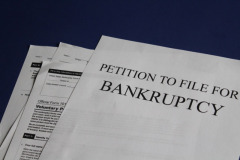What to Know About Filing Bankruptcy
Sometimes good people fall on hard times. Medical bills, divorces or being out of work for an extended period of time can all cause someone to get behind on their bills, mortgage or repayments for loans. You are in a financial slump, but you are ready to get back on track and put your finances back together. Perhaps you have considered filing bankruptcy, but you are unsure if that is the best thing for you. The first thing is to learn about the two most common types of bankruptcy. There is chapter 7, which is usually the easiest and cheapest to file, and chapter 13. Below we break down the difference between the two.
Chapter 7 Summary
Chapter 7 is the simplest common form of bankruptcy. Also known as straight bankruptcy, this type allows you to keep some of your property. However, what falls under the bankruptcy goes to a trustee who takes your property, sells it to buyers, and then takes the proceed to pay your creditors. Once all of the documents have been filed this process can take around six months to be completed.
Chapter 13 Summary
In the case of a chapter 13 bankruptcy, instead of making one big sale and pay off, filers are obligated to make payments on a monthly basis to creditors through a trustee. It can take anywhere from three to five years to completely pay off the debt. One of the primary reasons people file chapter 13 instead of chapter 7 is because they make too much money to qualify for the latter.
Benefits of Chapter 13
The payment plan option is one of the greatest benefits of filing chapter 13. It allows filers to catch up on their past due payments. This works for auto financing, the mortgage, taxes, and even child support. chapter 13 is the best option for people who prefer to know what exactly they will have to pay each year. Although it can be taxing living under chapter 13, if you plan correctly you can come out of this bankruptcy better than you went into it.
Realities of Chapter 13
Length of time: You can expect for your chapter 13 case to be open anywhere from three to five years, sometimes longer. Right now, reading this, three years may not seem like an exhaustive amount of time, but under bankruptcy, it can be. Many life changes can happen in three years. You could change jobs, have medical issues, have babies, or need major home repairs. Because these things can happen, making the monthly bankruptcy payments can become a very daunting task. Flexibility clauses can be written in your payment plan to account for the possibility of these life changes. Although bankruptcy attorneys and trustees cannot predict everything, they try to be reasonable in the chance these things do happen.
Before your payment plan is approved by the chapter 13 trustee and the Bankruptcy Court your income must be verified, and creditors must have time to file the proper claims. Once all those claims are in, they must be reviewed, and your expenses must be checked. This process can take several months. If you dispute any of the claims, a bankruptcy judge will step in to make a judgment. The complete process can take up to a year before you are set to make a payment.
People will Know: Years ago, people were chastised and ridiculed for filing bankruptcy. Within the last 40 years, one out of ten people files some type of bankruptcy. It simply does not have the social or business stigma that it used to. People don't expect you to announce that you filed bankruptcy, and most people respect your privacy. However, bankruptcy cases are apart of the public record, but unless someone is intentionally looking no one will ever know that you filed.
Exceptions: When you file chapter 13, many of the trustees will require that your wages be garnished through payroll. This means your employer's human resources department will be notified through payroll of your bankruptcy. If you can prove that notifying your employer of your bankruptcy will result in negative consequences at work, such as a demotion, loss of security clearance or termination, then you can petition the courts for permission to directly pay the trustee.
Creditors will be notified of your bankruptcy case. If any of your friends or family members are creditors, then they too will be notified. Co-signers for any bank accounts or loans will also be notified by the court.
Pay your bills: You will need to continue to pay your current bills in addition to the agreed upon chapter 13 monthly payment. If you are already responsible for child support, a mortgage, insurance, car payments, property taxes, or alimony you will still have to make these payments. Sadly, the burden of your chapter 13 payments and your current bill can become overwhelming and you can fall behind. If you fall behind on your car payments or mortgage while your case is open, lenders can ask the courts that your car is repossessed, and your home foreclosed on. These mentions to the courts are called Motion to Lift Stay and Motion For Relief From Stay. In the case of alimony or child support, if you are behind on your monthly payments when your chapter 13 payment plan ends, you will not be punished by the courts.
The information in this post is for educational purposes only. It should not be interpreted as legal advice.
Find Similar Articles
Contact Us
For more information please fill out the form below.
(*) - Required field

